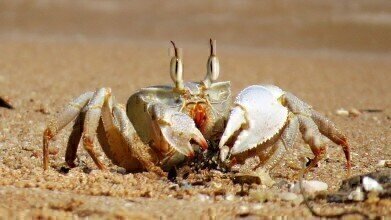Waste Management
Half a Million Crabs Killed by Plastic Pollution
Jan 02 2020
Over half a million hermit crabs have been killed by plastic pollution on several remote islands in the Indian Ocean and the South Pacific, according to an alarming new collaborative study. The authors behind the research are concerned that the pollution-related deaths could be part of a wider trend in a decline of the species globally.
The crab cadavers were found on the Cocos archipelago in the Indian Ocean and Henderson Island in the South Pacific. In all, a total of 508,000 crabs suffered premature deaths due to becoming trapped inside plastic debris. The study provides yet more evidence of the wide-ranging dangers that plastic pollution can cause to animals living both on land and in the sea.
Nowhere to go
The authors of the study examined four different Cocos islands and Henderson Island, each time looking for plastic containers whose sloping sides would prevent crabs from leaving once they had entered. They counted the number of bodies inside each container and extrapolated their findings across 15 more islands in the Cocos archipelago, reaching a total of 508,000.
“These results are shocking but perhaps not surprising, because beaches and the vegetation that fringes them are frequented by a wide range of wildlife,” explained Dr Jennifer Lavers, a scientist from at the Institute for Marine and Antarctic Studies (IMAS) at the University of Tasmania, who led the research. “It is inevitable that these creatures will interact with and be affected by plastic pollution, although ours is one of the first studies to provide quantitative data on such impacts.”
Indeed, the majority of research until now has focused on how plastic affects marine animals – especially highly dangerous microplastics, which can be mistaken for food and ingested by very small organisms. These are then consumed by larger ones and in this way, plastic pervades the entire food chain. However, the new study looked instead at the impact of plastic on land-dwelling animals.
A macabre chain reaction
The issue is exacerbated by the fact that hermit crabs do not have their own shell. As a result, the death of one crab emits a chemical signal which attracts others to the site of their expiry since their shell will now be available. It’s an ingenious quirk of nature which allows the animals to recycle the resources available to them.
However, when plastic pollution is involved, that chemical signal can serve as a homing beacon for crabs to meet their doom. Indeed, in one particularly grisly example, a staggering 526 bodies were found trapped within a single container. Given that similar results were found in two distinct locations globally, the researchers are concerned that the longevity of the entire species could be in jeopardy if the same occurs elsewhere as well.
If true, the study simply provides more urgent impetus for us to curb our polluting habits. While preventing plastic pollution from occurring in the first place would be the ideal outcome, scientists are continually working towards innovative ways of cleaning up that which has already infiltrated our waterways. In one striking example, forensic science and artificial intelligence are teaming up to combat the blight on Mother Nature.
Events
IWA World Water Congress & Exhibition
Aug 11 2024 Toronto, Canada
Aug 25 2024 Stockholm, Sweden and online
Sep 03 2024 Mexico City, Mexico
Sep 03 2024 Mexico City, Mexico
Sep 03 2024 San Diego, CA, USA













